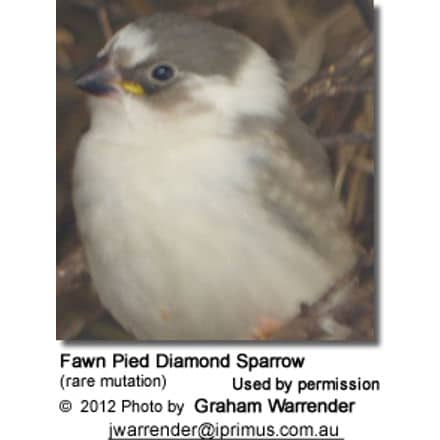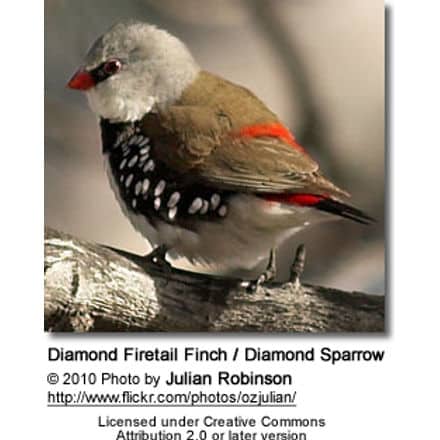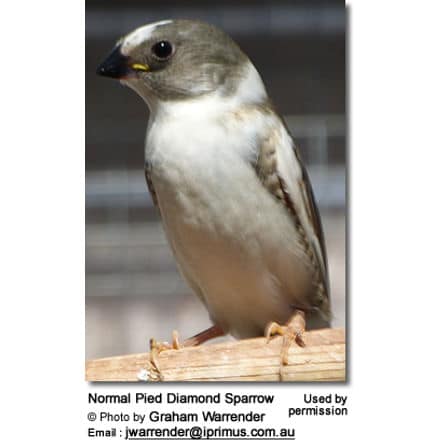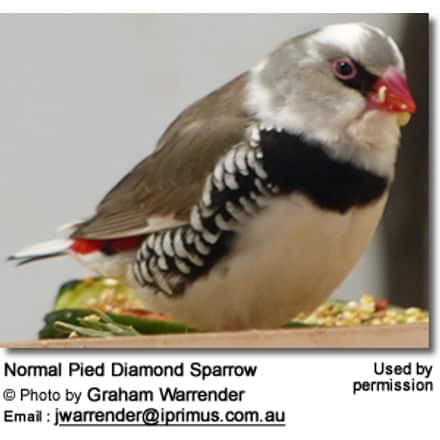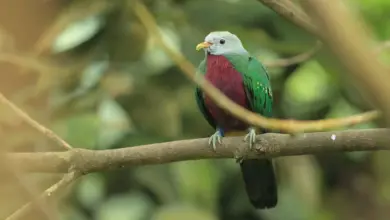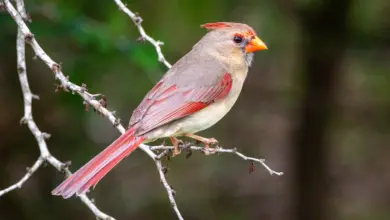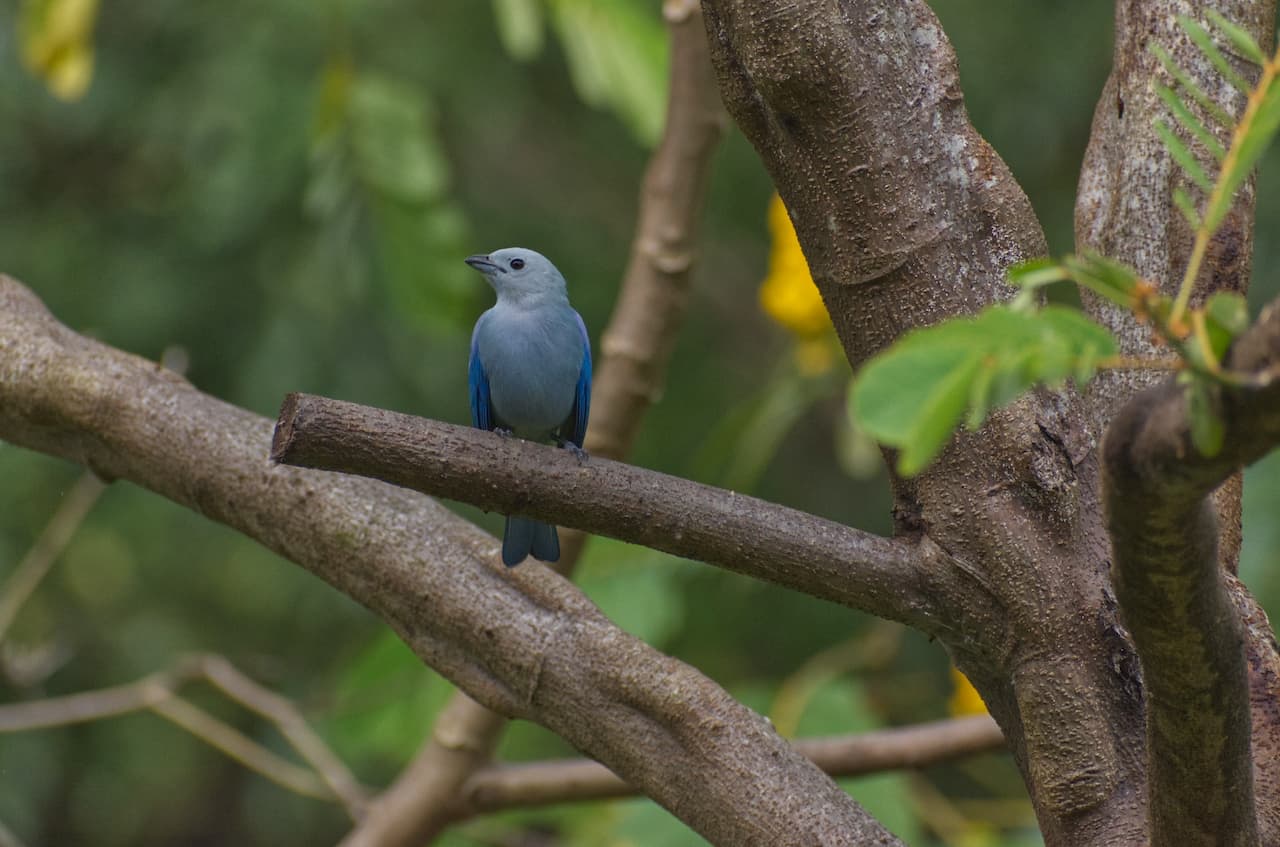Breeding Diamond Firetail Finches or Diamond Sparrows
Choosing healthy Diamond Firetails is of utmost importance. The following are clues to look out for …
The plumage should be smooth, clean, and tight. The vent should be clean (a wet, dirty vent is caused by diarrhea, which could be a sign of disease).
The legs and feet should be free of scaling. The toes should not be overgrown.
The Diamond Sparrow should be of a good size (not too small/feeble)
The eyes should be clear, and bright and the area around the eyes should be dry.
Birds with watery eyes are likely sick. Very sick birds usually fluff their feathers up to keep warm and may sit on a perch or the floor with their eyes closed.
If they don’t move as you approach, they are likely to be close to death.
Any Diamond Sparrows to be introduced into an existing communal aviary should be quarantined as many health problems may not be apparent for several weeks or even months.
The stress of the move usually brings them out within a month or two. If they have already been introduced into an aviary, all other birds could have already been infected by then. Please refer to quarantine procedures.

Pairing / Repairing
Pairing Diamond Firetail finches poses several challenges. First of all, males and females look very much alike. Even though there are some slight differences – those may not be noticeable, especially in young birds.
Males are most easily identified by their courtship displays and their songs. Some breeders suggest observing these finches for a while and choosing a pair with voices that are the most different.
However, ensuring that you have both males and females in an aviary is not sufficient. They need to be compatible.
One proven practice is to house a group of Diamond Sparrows together and allow them to choose their own mates.
Once they find suitable mates, they form strong pair bonds and pairs usually remain together for life.
If say the female dies, then it is recommended to add at least two females for the male to choose from. Some will take another mate pretty soon, while others take a long time to commit to another mate.
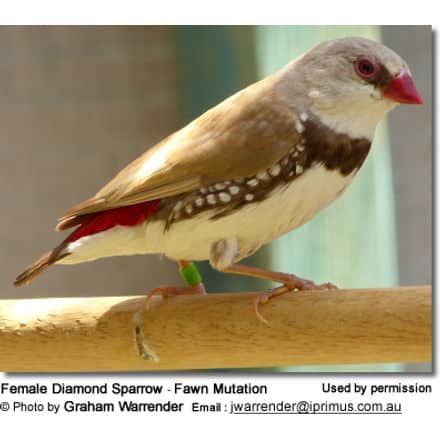
Breeding Readiness
Even though Diamond Sparrows could start breeding when they are as young as 5 or 6 months old, it is best to discourage that until they are 10 months or a year old to minimize the risk of egg binding in young females.
Housing
Aviaries
- Provided sufficient space is available for all, Diamond Firetails usually do well in mixed aviaries, as they usually get along well with finches of their own size, such Chestnut-breasted Finches, Java Finches, Red-headed / Paradise or Aberdeen Finches, Golden Song Sparrows, Cutthroats, Zebra or Orange-breasted Waxbills, Cordon Bleus, Red Strawberries, Long-tailed Grassfinches and Chaffinches.
However, they may bicker and be aggressive towards smaller wax bills may stop smaller birds from breeding, and may stress them to the point of dying.
They may also fight with males of their own species. If several breeding-age pairs of Diamond Firetails are kept in the same flight, it has been noted that only one pair may actually nest and produce young.
For this reason, it’s best to separate Diamond Firetails into different flights. This being said, some report problems, and others don’t.
It is always important to watch birds for compatibility for some time after they have been placed into a communal aviary to see how they get along and remove those that get either too stressed or those that are bullying the other occupants.
MINIMUM Aviary / flight size suitable for:
one breeding pair: 6 feet (1.8 meters) long x 3.3 feet (1 meters) deep
up to 12 inches: 15 feet (4.5 meters) long x 13 feet (4 meters) deep.
Breeding Cages
- Even though these finches can be housed in cages, they are prone to obesity if they don’t have the opportunity to exercise/fly every day. They also tend to stress out when confined in small spaces, which will weaken their immune system and lower their productivity (as far as breeding is concerned). A large, planted flight/aviary is preferable. However, pairs may need to be separated when they are in breeding mode to avoid aggression towards other birds.
- Breeding cages should be at least 24 inches (0.6 meters) long.
Temperatures
- Ambient temperatures should not be allowed to go below 54°F or 12°C. Some sources of heat may need to be provided during cold spells.
Placement
- Nesting Diamond Sparrows should not be disturbed as they are quick to abandon an active nest. Since they spend a lot of time on the ground, their enclosure should include a large, open floor space that is easy to keep clean.
Nesting / Raising of the Young
In the wild, Diamond Firetails construct an elaborate bottle-shaped dome nest with an outer shell of green grasses and a small woven entrance funnel on the front. The males generally gather the nest materials and the females do all the weaving.
Some Diamond Sparrows – particularly those that were raised (fostered) by other finches – may accept large wicker or wire baskets, gourds, logs, wire cylinders, finch nest boxes, or half-open nest boxes for nesting.
They generally favor nestboxes in which they can hide. Diamond Firetails also like to roost in their nests at night.
Others prefer to construct their own nests. They will use whatever they find in their environment to get the job done – including long grass strips (about 8 – 10 inches is ideal), coco fiber, shredded paper, dried grasses, sisal, cotton wool, strings, fur, plant matter, twigs, tissue paper and feathers (for lining).
In a pinch, they may demolish the wicker baskets of other finches to construct their own nests. In order to prevent this from happening, it’s important to provide a large volume of nesting material at all times. Once completed, their nests often resemble domes or footballs.
Nesting pairs often place their nests close to each other – often high up and behind some natural cover. As long as plenty of nesting material is available to all, they usually remain quite peaceful.
The average clutch consists of 4 – 6 eggs, which she mainly incubates for about 14 days, however, the male will assist as needed.
Usually, only one clutch is laid per season.
The hatchlings are pink-skinned and with very little down. Both parents feed and care for them. They will leave the nest when they are about 21 days, old but continue to be cared for by their parents until they are about 42 days old, at which time they are generally weaned and independent.
Mutations
In captivity, several attractive mutations have been produced …
- Yellow Diamond Firetail Finch – The areas on the tail that are red in the normal plumaged bird are yellowy-orange in the Yellow Diamond.
- Silver Diamond – plumage mostly a silvery white, paler below. The rump is a lighter red.
- Pied Diamond with splashes of white. Some argue that these plumage differences may be caused by age rather than being a genuine mutation. However, pied mutations are common amongst many finch species and are accepted by most as a genuine mutation.
- White Diamond – generally not long-lived
- Fawn Diamond – a sex-linked mutation
Exhibitions
It is no surprise that the attractive Diamond Firetails are very popular show birds.
The judges typically look for an overall even-colored plumage, the size, and evenness of the chest band and the dots on the flanks, size, and shape of the bird.
The tightness of feathers and lack of pinfeathers are further considerations.
Banding / ID
Close-banding is problematic with these finches if they are parent-raised. There is only a very narrow window of opportunity for the fitting of the leg band, which is when they are about 7 – 10 days old.
Before this time, the band will be too loose and after that, the band won’t fit over their feet. For these finches, one usually uses closed aluminum bands, as split bands won’t stay on the chick’s legs.
Engraved on those bands are usually the hatch year (last two digits) and a serial number which identifies the chick’s parents and facilitates record keeping.
They may also have the initials of the aviary/breeder they came from or from the bird club.
Some breeders choose not to ring their chicks if there is no legal requirement for them to do so. They can sometimes cause injury as chicks get hung up in the nest.
Close bands can be purchased through many bird clubs or leg band companies, such as L and M Bird Bands.
The problem with Diamond Firetails is that the chicks would have to be taken out of the nest for banding and the parents almost always abandon the young afterwards.
It would also be difficult to get the young out of the dome-shaped nest without destroying it.
In this case, open plastic (split) rings work better. If close banding is of high importance, it is best to have the young raised by foster parents (often Society / Bengalese finches).
Health
Since Diamond Sparrows spend a lot of time on the ground feeding, they are susceptible to parasitic worms and in flights with wet areas, coccidia is a common problem. These finches should not be allowed to feed on wet floors. A strict worming and coccidial program may be required in certain outdoor flights. They are also prone to fungal infections.
Diet / Feeding
In the wild …
Diamond Firetails feed on ripe or partially ripe seeds and leaves of grasses and herbs, insects and their larvae (particularly when breeding), and ripe or partially ripe fruits.
These ground feeders act as seed disperses of the plants they feed on.
Unlike other finches, Diamond Firetails drink water by sucking.
Captive feeding …
Diamond Firetails should be fed …
- a quality finch mix consisting of mixed millets and canary seed
- heads of seeding grasses and other fresh greens (dandelions, chickweed, endive, summer/winter grass, Guinea / Newcastle grass, milk thistles, shepherd purse, and clover pulled from the ground with earth still attached; as well as lettuce, Kale spinach, chickweed, spray millet, broccoli tops, carrot tops)
- Some mineral block, crushed eggshell, or cuttlebone should be available as well (needed for strong bones and egg formation)
- Breeding Diamond Sparrows should have access to live food (insects – such as termites, small crickets small cockroaches, and other crawly small insects; meal worms, etc.) and food.
- Sprouted Seeds: Sprouted or germinated seeds are usually more easily accepted by “seed addicts” than fresh fruits and vegetables.
- Sprouted seeds are healthier as the sprouting changes and enhances the nutritional quality and value of seeds and grains. Sprouted seeds are lower in fat, as the process of sprouting utilizes the fat in the seed to start the growing process – thus reducing the fat stored in the seeds. Sprouted seeds will help balance your bird’s diet by adding a nutritious supply of high-in vegetable proteins, vitamins, minerals, enzymes, and chlorophyll. Soaked and germinated “oil” seeds, like niger and rape seeds, are rich in protein and carbohydrates; while “starch” seeds, such as canary and millets, are rich in carbohydrates, but lower in protein. It is an invaluable food at all times; however, it is especially important for breeding or molting birds. Sprouted seeds also serve as a great rearing and weaning food as the softened shell is easier to break by chicks and gets them used to the texture of seeds.
